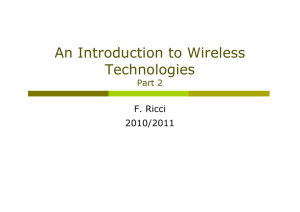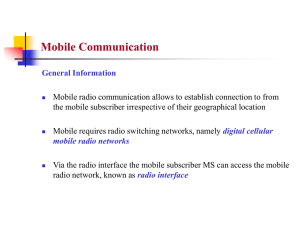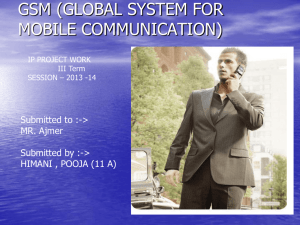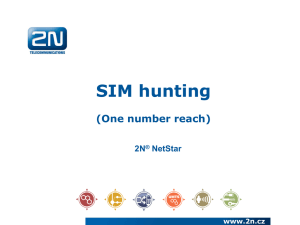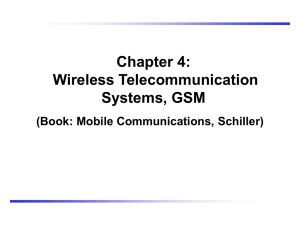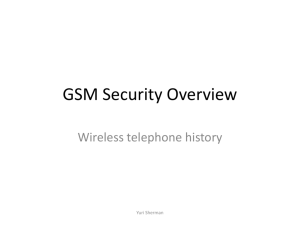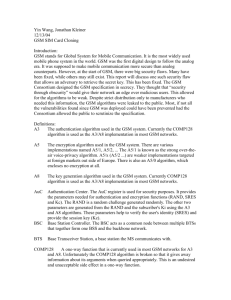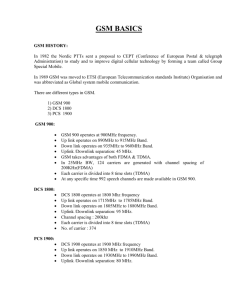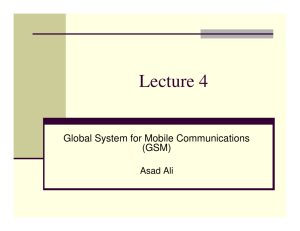2 Base Station Sub-system (BSS)
advertisement
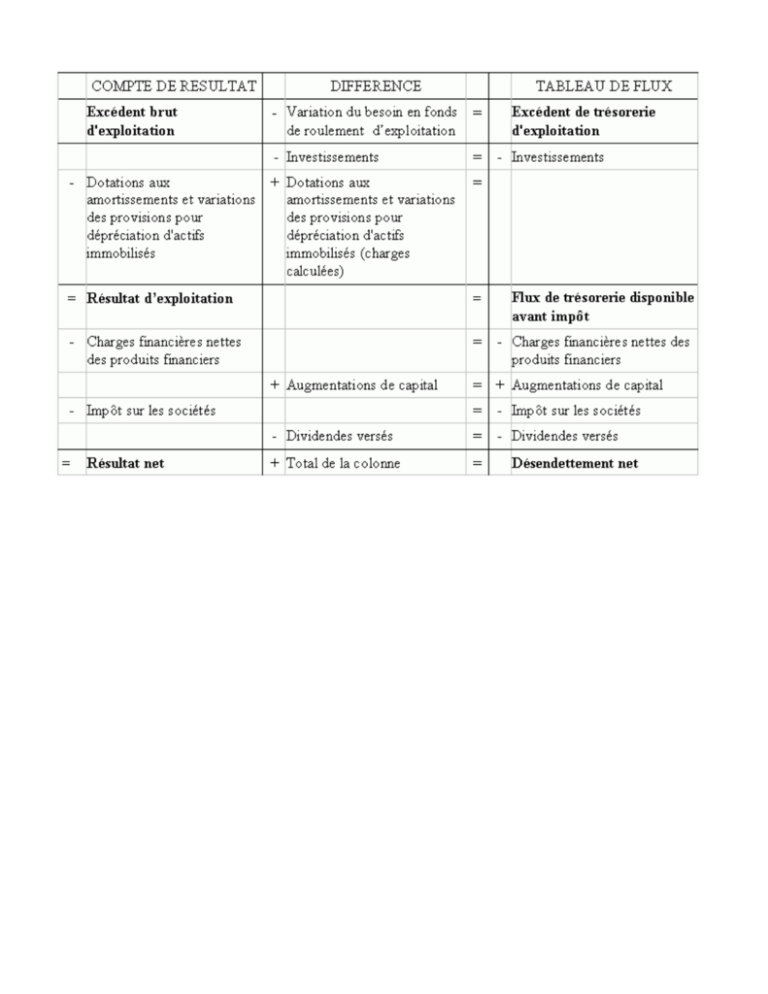
METHODE DIRECTE METHODE INDIRECTE (le plus souvent soustractive) (le plus souvent additive) Excédent Brut d'Exploitation Produits d'exploitation (devenant (EBE) tôt ou tard des recettes d’exploitation) - Charges d'exploitation (devenant tôt ou tard des dépenses d’exploitation) Résultat net + Impôt sur les sociétés - (+) Profits et charges exceptionnels + Charges financières nettes + Dotations aux amortissements et variation des provisions sur actifs immobilisés Capacité d'Autofinancement Excédent Brut d'Exploitation (CAF) - Charges financières nettes Résultat net ++ Dotation aux amortissements et variation des provisions sur +(-) Profits et charges exceptionnels actifs immobilisés et pour risques (ayant un impact en trésorerie) et charges - Résultat d’exploitation Impôt sur les sociétés -/+ Plus-values (moins-values) de cession d'actifs Excédent Brut d'Exploitation Résultat net - Dotation aux amortissements et + Impôt sur les sociétés variation des provisions sur actifs - (+) Profits et charges immobilisés exceptionnels + Actif économique Actif immobilisé + Endettement net Besoin en fonds de roulement Actif économique - Charges financières nettes Capitaux propres + Endettement net Endettement financier (court, moyen et long termes) Capitaux propres - Placements financiers - Disponible Besoin en fonds de roulement Stocks + Encours clients et autres créances d'exploitation et hors exploitation - Encours fournisseurs et autres dettes d'exploitation et hors exploitation Actif économique - Immobilisations Excédent de trésorerie d'exploitation Recettes d'exploitation - Dépenses d'exploitation Flux de trésorerie disponible Excédent de Trésorerie avant impôt d'Exploitation - Investissements nets des cessions Flux de trésorerie provenant de l’exploitation Capacité d’autofinancement - Variation du Besoin en Fonds de Roulement d’exploitation Excédent Brut d'Exploitation - Variation du besoin en fonds de roulement d'exploitation ^^^^ Effet de levier Courbes des taux d'intérêt dans le monde (mai 2002) Evolution de la prime de risque anticipée GSM -> Architecture Architecture of the GSM network Mobile Station Base Station Subsystem Network Subsystem ,---------------------------------------------------------------------------, | Um A | | Interface A-bis Interface | | | Interface | ,--------------------, | | | ,-----, ,-----, | | | | ,----------|----------, | | | VLR | | HLR | | ,-------, | | ,-----, | ,-----, | | `-----' `-----' | | Other | | | | SIM | | | | BTS | | ,-----, | | | ,-----, | | MSCs | | | `--,--' | `-----'---| | | | | |--------------'-------' | | | , | : | | BSC |-----------| MSC | | | | ,-----, /| | ,-----,---| | | | | |--------------,------, | | | MS |' | ,---| BTS | | `-----' | | | `-----' | / PSTN / \ | | `-----' |/ | `-----' | | ,-----, ,-----, | \ ISDN / | | ' `----------|----------' | | | EIR | | AC | | `------' | | | `-----' `-----' | | | | Base Station Subsystem `--------------------' | | Network Subsystem | `----------------------------------------------------------------------------' SIM Subscriber Identity Module HLR Home Location Register MS Mobile Station VLR Vistor Location Register BTS Base Transceiver Station EIR Equipment Identity Register BSC Base Station Controller AC Authentication Center MSC Mobile services Switching Center PSTN Public Switched Telecomm Network VLR Visitor Location Register ISDN Integrated Services Digital Network FIGURE 1 A GSM network is composed of several functional entities, whose functions and interfaces are defined. Figure 1 shows the layout of a generic GSM network. The GSM network can be divided into three broad parts. The Mobile Station is carried by the subscriber, the Base Station Subsystem controls the radio link with the Mobile Station. The Network Subsystem, the main part of which is the Mobile services Switching Center, performs the switching of calls between the mobile and other fixed or mobile network users, as well as management of mobile services, such as authentication. Not shown is the Operations and Maintenance center, which oversees the proper operation and setup of the network. The Mobile Station and the Base Station Subsystem communicate across the Um interface, also known as the air interface or radio link. The Base Station Subsystem communicates with the Mobile service Switching Center across the A interface. Mobile Station The mobile station (MS) consists of the physical equipment, such as the radio transceiver, display and digital signal processors, and a smart card called the Subscriber Identity Module (SIM). The SIM provides personal mobility, so that the user can have access to all subscribed services irrespective of both the location of the terminal and the use of a specific terminal. By inserting the SIM card into another GSM cellular phone, the user is able to receive calls at that phone, make calls from that phone, or receive other subscribed services. The mobile equipment is uniquely identified by the International Mobile Equipment Identity (IMEI). The SIM card contains the International Mobile Subscriber Identity (IMSI), identifying the subscriber, a secret key for authentication, and other user information. The IMEI and the IMSI are independent, thereby providing personal mobility. The SIM card may be protected against unauthorized use by a password or personal identity number. Base Station Subsystem The Base Station Subsystem is composed of two parts, the Base Transceiver Station (BTS) and the Base Station Controller (BSC). These communicate across the specified Abis interface, allowing (as in the rest of the system) operation between components made by different suppliers. The Base Transceiver Station houses the radio tranceivers that define a cell and handles the radiolink protocols with the Mobile Station. In a large urban area, there will potentially be a large number of BTSs deployed. The requirements for a BTS are ruggedness, reliability, portability, and minimum cost. The Base Station Controller manages the radio resources for one or more BTSs. It handles radiochannel setup, frequency hopping, and handovers, as described below. The BSC is the connection between the mobile and the Mobile service Switching Center (MSC). The BSC also translates the 13 kbps voice channel used over the radio link to the standard 64 kbps channel used by the Public Switched Telephone Network or ISDN. Network Subsystem The central component of the Network Subsystem is the Mobile services Switching Center (MSC). It acts like a normal switching node of the PSTN or ISDN, and in addition provides all the functionality needed to handle a mobile subscriber, such as registration, authentication, location updating, handovers, and call routing to a roaming subscriber. These services are provided in conjuction with several functional entities, which together form the Network Subsystem. The MSC provides the connection to the public fixed network (PSTN or ISDN), and signalling between functional entities uses the ITUT Signalling System Number 7 (SS7), used in ISDN and widely used in current public networks. The Home Location Register (HLR) and Visitor Location Register (VLR), together with the MSC, provide the callrouting and (possibly international) roaming capabilities of GSM. The HLR contains all the administrative information of each subscriber registered in the corresponding GSM network, along with the current location of the mobile. The current location of the mobile is in the form of a Mobile Station Roaming Number (MSRN) which is a regular ISDN number used to route a call to the MSC where the mobile is currently located. There is logically one HLR per GSM network, although it may be implemented as a distributed database. The Visitor Location Register contains selected administrative information from the HLR, necessary for call control and provision of the subscribed services, for each mobile currently located in the geographical area controlled by the VLR. Although each functional entity can be implemented as an independent unit, most manufacturers of switching equipment implement one VLR together with one MSC, so that the geographical area controlled by the MSC corresponds to that controlled by the VLR, simplifying the signalling required. Note that the MSC contains no information about particular mobile stations - this information is stored in the location registers. The other two registers are used for authentication and security purposes. The Equipment Identity Register (EIR) is a database that contains a list of all valid mobile equipment on the network, where each mobile station is identified by its International Mobile Equipment Identity (IMEI). An IMEI is marked as invalid if it has been reported stolen or is not type approved. The Authentication Center is a protected database that stores a copy of the secret key stored in each subscriber's SIM card, which is used for authentication and ciphering of the radio channel. 1 GSM Network Architecture The GSM Architecture consists of three major sub-systems. These are Base Station Sub-System (BSS) that provides the air interface for Mobile Stations (MS), Network Sub-System (NSS) that connects calls between users, and Operation Sub-System (OSS) that allows remote monitoring and management of network. SIM - Subscriber Identity Module, ME - Mobile Equipment, BTS - Base Transceiver Station, BSC - Base Station Controller, TCU Transcoder Unit, MSC - Mobile Switching Centre, PSTN - Public Switched Telephone Network, HLR - Home Location Register, VLR - Visitor Location Register, AUC - Authentication Centre, EIR - Equipment Identity Register, OMC - Operations & Maintenance Centre, OMC-R - OMC devoted to BSS, OMC-S - OMC devoted to NSS. 2 Base Station Sub-system (BSS) The Base Station function is divided into two main functional elements, the Base Station Controller (BSC) which also includes the Transcoder Unit (TCU), and the Base Transceiver System (BTS). The BSC can control several BTS units. Each BTS will consist of a number of transceivers (TRX) and will serve a cell or a number of cells. The BSC unit also performs transcoding functions to convert between 64Kbps channel rate used in the Switching System and the 16Kbps channel rate for GSM traffic. 3 Network Switching Sub-system (NSS) The switching system connects mobile subscribers to other mobile subscribers in the same network or to other networks. To perform this function a number of Mobile Switching Centres (MSC) are employed. However to connect to users on another network requires a Gateway MSC (GMSC) which provides interconnection between different networks. Associated with the MSC are location registers and authentication functions that allow the network to locate and validate system users. There is one Home Location Register (HLR) and Authentication Centre (AUC). However, each MSC has a Visitor Location Register (VLR) associated with it. 4 Operation Sub-System (OSS) The OMC provides remote monitoring of the network performance and permits remote re-configuration and fault management activity as well as alarm and event monitoring. 5 Mobile Station (MS) The MS comprises of Mobile Equipment (ME) and a Subscriber Identity Module (SIM). The ME contains the software and hardware to operate as a mobile radio terminal. The SIM in conjunction with the network Authentication Centre (AUC) validates the MS. 6 UMTS Network Architecture One of the requirements for the Release 99 Architecture is to support roaming and inter-operation with the GSM system, hence the GSM system appears as one of the components of the UMTS Release 99 Architecture. USIM - UMTS Subscriber Identity Module, UE - User Equipment, Node B - UMTS Base Station, SRNC - Serving Radio Network Controller, DRNC - Drift Radio Network Controller, SGSN - Serving GPRS Support Node, GGSN - Gateway GPRS Support Node, PDN - Public Data Network, SIM - Subscriber Identity Module, ME - Mobile Equipment, BTS - Base Transceiver Station, BSC Base Station Controller, MSC - Mobile Switching Centre, GMSC - Gateway Mobile Switching Centre, PSTN - Public Switched Telephone Network, HLR - Home Location Register, VLR - Visitor Location Register. 7 CS-Domain This is the Circuit Switched domain that is traditionally known to provide services such as speech calls. The Core Network (CN) component that implements the CS services for UMTS is the 3G-MSC. 8 PS-Domain This is the Packet Switched domain that is known to provide services such as IP Based traffic. The CN component that implements the PS services for UMTS is the 3G-SGSN. 9 UMTS Terrestrial Radio Access Network (UTRAN) This consists of the Radio Network Controller (RNC) and the Node B. The UTRAN is responsible for functions that relate to access, radio mobility and resource utilisation. The Serving Radio Network Controller (SRNC) is responsible for the logical connection between the UE and the CN. The Drift Radio Network Controller (DRNC) provides additional radio resources for a UE that is in a dedicated connection and a soft-handover state. The Node B that is attached to the DRNC will provide the physical resource to the UE, and the information on the uplink and the downlink is routed towards the SRNC. 10 User Equipment (UE) The radio terminal that the subscriber uses to receive service from the UTRAN is known as the UE. This will arrive in the form of PDA terminals and Handsets similar to current GSM mobiles. The UE's will be supporting multimode GSM, GPRS and UMTS services. They will be supporting multi-band GSM900, DCS1800 and PCS1900 systems. The capabilities of these User Equipments will vary hence the UTRAN will read UE capabilities during set-up.
